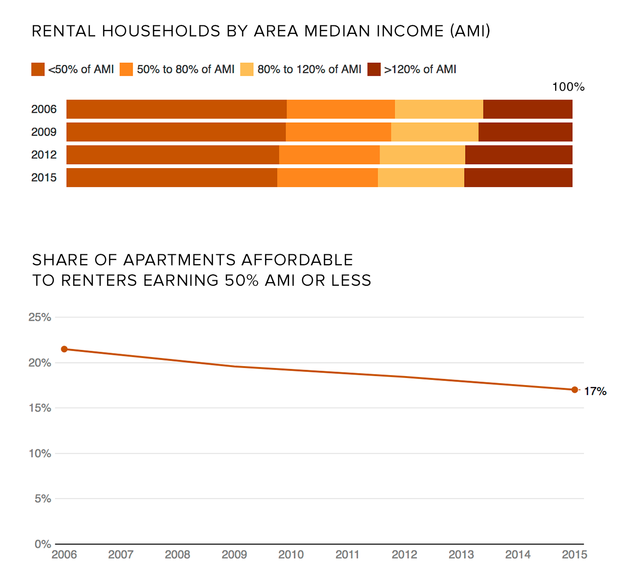As high earners push up rents, fewer options for others
The rent for many Americans is still too damn high, according to a new analysis of 53 metropolitan areas.
Nationally, 46 percent of households, or more than 12 million families and individuals, were "rent-burdened" in 2015, New York University's Furman Center said in the report. A rent-burdened household is defined as one in which more than 30 percent of income (before taxes) goes toward paying the rent.
The percentage of Americans who are spending more on rent has risen sharply in recent decades. In 2000, 36 percent of households were considered rent-burdened, while the latest figure is nearly twice the rate from 1970, when about a quarter of households struggled, according to the analysis, which is based in part on the most recent available federal data.
Although the share of rent-burdened households has dipped 1.2 percentage points from 2012, that drop may not represent good news for most renters. Here's why: The study shows that growing numbers of better-educated, higher earners are choosing to rent instead of buying a home, especially in faster-growing cities. That changes the overall income profile of who is renting.
"Renters as a group are different than they were three years ago, and certainly than they were a decade ago," said Sewin Chan, an associate professor of public policy at NYU Wagner and a research affiliate at the NYU Furman Center, in a call with reporters.
That can mean fewer options for lower-income households. What's more, people who moved in the past 12 months were more likely to pay higher rent, according to the study, which examined 53 metropolitan areas with more than 1 million people each.
Pressure from tightening mortgage lending, rising credit-score requirements, and rising non-household consumer debt from areas like student loans, autos and credit cards are keeping people from buying instead of renting, said Alanna McCargo, co-director of housing at the Urban Institute's Finance Policy Center, during a panel discussion at NYU on the findings.
"Seven million people over the last 10 years have lost their homes," she said. "They're living somewhere now, and that has a lot to do with why there's been so much pressure on rents and prices."
Such economic conditions also can make it difficult to save for a down payment for a home, said Marion Mollegen McFadden, vice president of public policy at Enterprise Community Partners, during the panel discussion. The racial wealth gap may also play a part, she said.
"So many homeowners start at the 'bank of mom or dad' to get a down payment," McFadden said. "So looking at the millennial generation as our largest and most ethnically diverse generation, I think we're seeing the impact of that."
Rents for newly available apartments overall in 2015 were 4.8 percent higher than rents where tenants stayed put. That pattern held true in 51 of 53 areas included in the study. It gets worse for those who need to move and earn half the median income across the areas studied. That group could afford just 17 percent of recently available units in 2015, down from 21.5 percent in 2006, according to the study.
For examples of how rents differ by area, a recently available Los Angeles two-bedroom rented for $1,760, $330 above the median, according to the study. But in the Minneapolis-St. Paul area, someone looking to move would pay about $970, $10 less than the median rent in the area.
In San Francisco and San Jose, California, two-bedroom units that were recently available were 30 percent more expensive than homes in that area as a whole. However, Grand Rapids, Michigan, and Minneapolis didn't command such a premium.
For a two-bedroom unit, the median rent across all areas was $1,050. About 40 percent of households rented rather than owned in the 53 areas surveyed.
The share of households earning more than 120 percent of an area's median income rose by 1.2 percentage points between 2012 and 2015 to 21.2 percent. The share of renters with income below 50 percent of that threshold was little-changed, falling 0.2 percentage points to 63.9 percent in the same period, according to the study. The median income was $61,000 in 2015 for the 53 cities studied.
Seven metropolitan areas had fewer than 10 percent of apartments available for "severely burdened" households, or those who pay more than 50 percent of their income. All of them were in Florida or California. In Florida, Orlando, Miami, Tampa, Jacksonville had tight housing, and in California, San Diego, Los Angeles and Riverside were in that category.
The study's figures were derived using 2015 data from the U.S. Bureau of Labor Statistics' unemployment rate and the census database at the Minnesota Population Center at the University of Minnesota, among other sources.
The NYU study echos findings from a Harvard University study released over the summer. That analysis found that the share of American households who rent their homes reached a 50-year high, at about 37 percent.





